Anyone questioning why a report highlighting the disconnect between how our world is and how we often think it is goes under the title “the Perils of Perception” need look no further than slightly east and further west towards Brexit and Donald Trump.
The surprise election of the latter as US president in late 2016 and the ratification of the former months earlier show how important our perceptions are when we make decisions. Perilous misperceptions can reshape our world in ways which would once have been unimaginable.
One of the key reasons UK voters gave for backing Brexit by a slim margin four years ago was because they believed – or were led to believe – that the level of immigration in the UK was much higher than it actually was.
Trump, meanwhile, was swept to power in the US at least in part because he and his surrogates carefully crafted a fake narrative which had millions of rapists pouring across the country’s southern border cheered on by his opponent Hillary Clinton.
While the most recent election in this country in February did not cause a shock as seismic as Brexit or the presidency of Trump, the result was at least in part driven by misperceptions as about the State we're in, says one of the architects of the Irish Times/Ipsos MRBI Perils of Perception survey Damien Loscher.
The Ipsos managing director points out that two of the touchstone issues in the election were health and housing, but suggests that people may have perceived both to be more problematic than was the case.
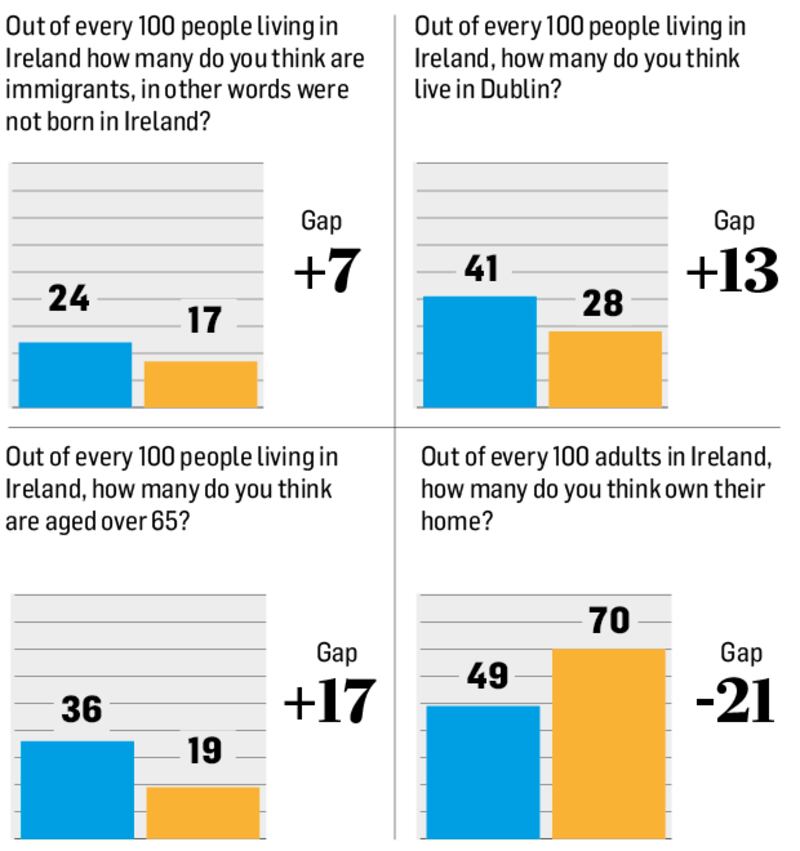
Housing
According to the 708 people whose views were sought for the poll, just 49 per cent of Irish adults are home-owners, while a similar number are renters and consequently more vulnerable to the housing crisis.
Meanwhile, people believe almost 46 per cent of 25- to 34-year-olds still live with their parents, presumably trapped by sky-rocketing rents and a chronic accommodation shortage.
However, official figures show that 70 per cent of Irish adults are home-owners, while 30 per cent rent, and just one in five of those aged between 25 and 34 lives at home.

Loscher is anxious not to downplay the impact the housing crisis has on many thousands of people and the difficulties many have in putting a roof over their heads, but he stresses that while things may be bad, they are not perhaps quite as bad as many people think they are.
Similarly, Irish people appear to underestimate how happy and healthy the nation is, something which fuels discontent. Some 86 per cent of Irish people describe themselves as happy but respondents to the perception poll guess on average that just 55 per cent feel contented.
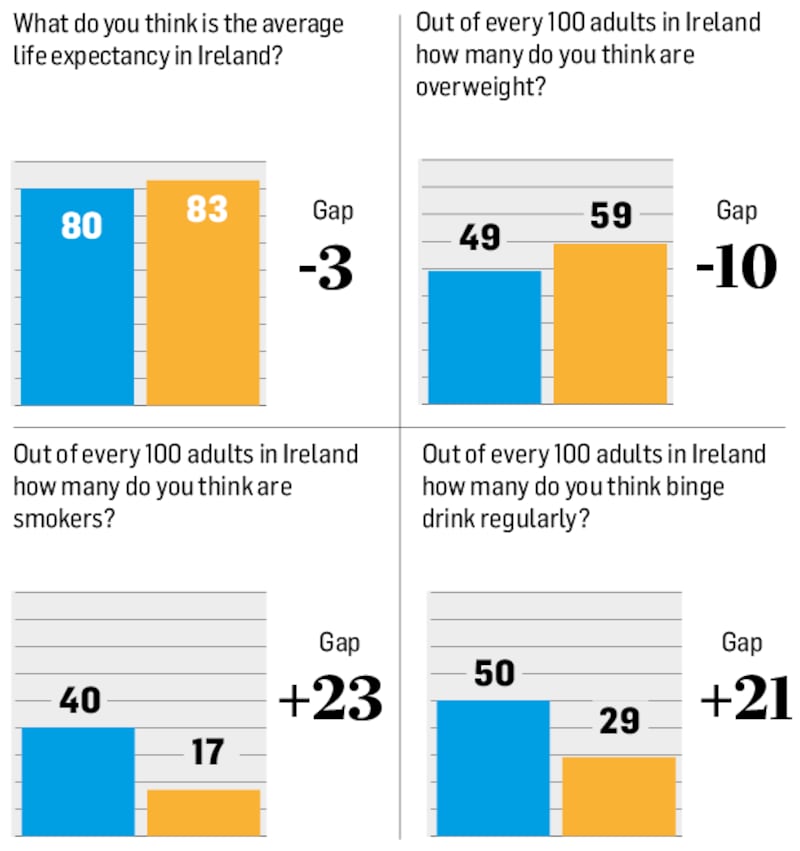
When asked what proportion of Irish people rate their health as good or very good, those surveyed guess 60 per cent, while the reality is 84 per cent.
Irish people also reckon other people are older, slimmer and richer than they actually are, and the survey suggests we also have a skewed understanding of the disparities between public and private sector wages.
Migration
Respondents to the survey substantially overestimate the level of immigration into Ireland, suggesting a rate of 23.9 per cent compared with the reality of 17.3 per cent.
They also believe 41 per cent of Irish people live in Dublin (28.4 per cent actually live in the capital), a perception that may be amplifying the rural-urban divide.
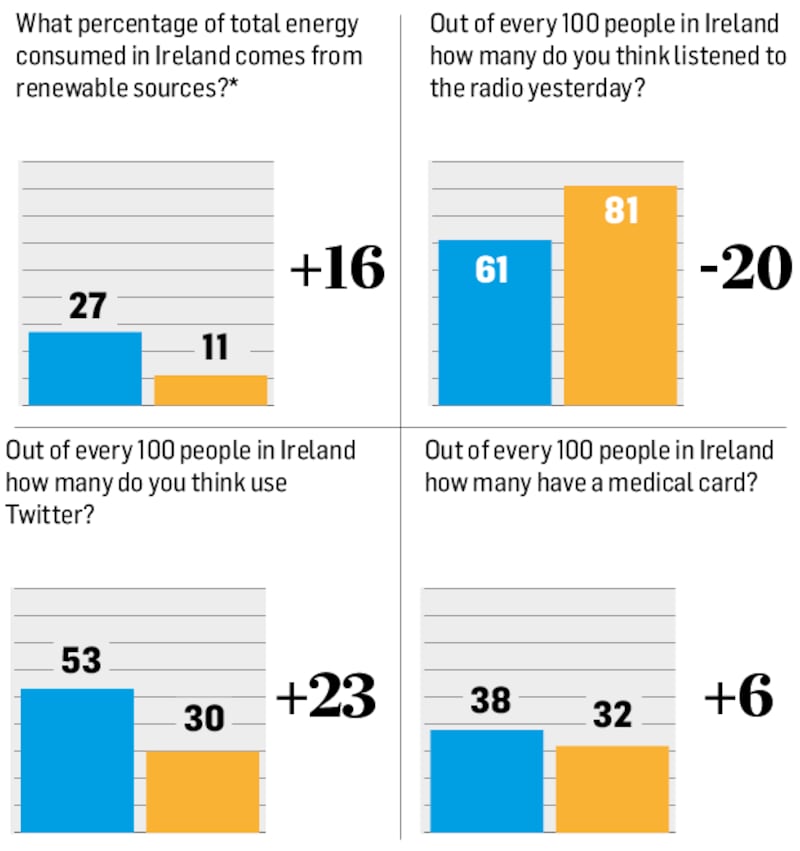
When asked about the percentage of the population who listened to the radio yesterday, the average perception was 60.5 per cent compared with a reality of 81 per cent, suggesting that a majority of people still use traditional media.
People, meanwhile, also dramatically overestimate how many adults use Twitter, putting the number at 53 per cent, while the actual number is a more modest 30 per cent.
“One type of bias that is not usually referenced in these studies but is hugely influential is the change bias,” Loscher says. “Where there is genuine social change happening, people tend to exaggerate the rate or extent of this change.
“We see this in the public’s overestimation of immigration, social media usage, urbanisation or the proportion of young people still living at home with their parents. Probably this perception reality-gap is driven by a combination of social change being especially newsworthy or interesting, and our primitive programming that sensitises us to any changes in our environment.”
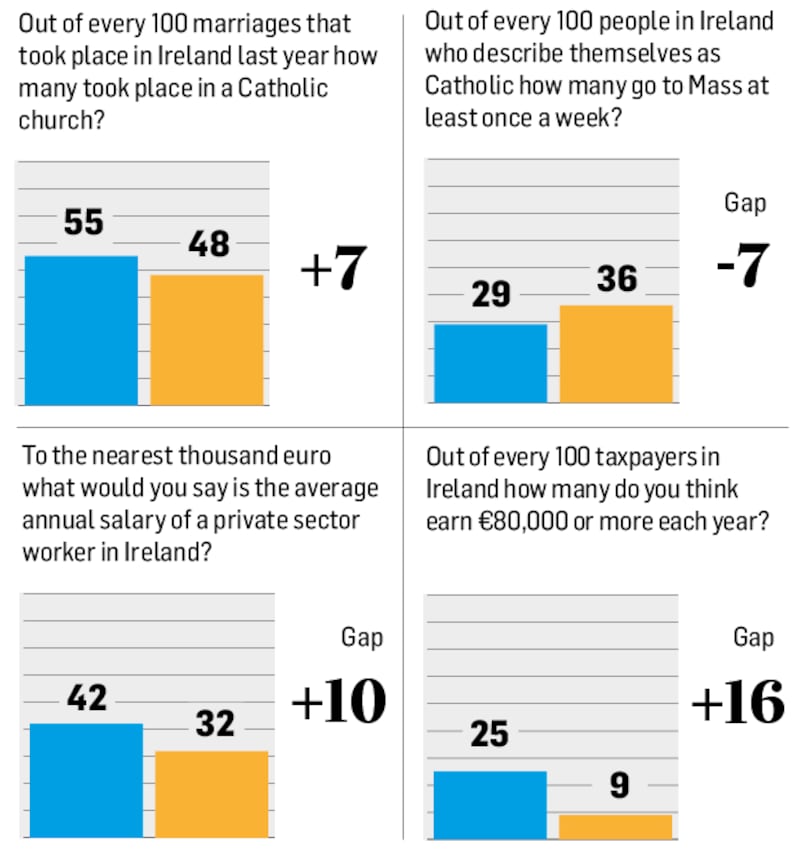
People also appear to believe other people are better off than they are. They think one in four people earns more than €80,000 a year. In truth fewer than one in 10 actually earn that income.
And there is a widely held view that private sector workers are paid better than they are, while public sector employees are worse off.
People asked to estimate the average annual salary of a private sector worker in Ireland to the nearest €1,000 guessed €41,600. The average wage in the private sector is actually €32,000.
When a similar question was posed about public sector workers, the perception was that they earn €37,300 on average, while the actual average is €47,000.
“People think those working in the public sector earn less than they do and less than those in the private sector, when they actually earn more,” Loscher says. “The gap between perception and reality is perhaps because that the public sector has vocal unions who are much better at PR.”
Welfare spending
When asked what percentage of government spending they think goes on social protection, including the State pension, unemployment benefits, child benefit and similar payments, the average guess was 36 per cent. It is 27 per cent.
And when asked how many of every 100 households receive the majority of their income from social welfare payments, the average answer was 35.2 per cent. The the actual figure is 27 per cent.
According to perceptions just over 36 per cent of the Irish population is aged 65 or over, while the actual percentage is 19 per cent. People also think as a nation that we are slimmer than we are. The average guess was that 49 per cent of Irish people are overweight, compared to the reality of 59 per cent.
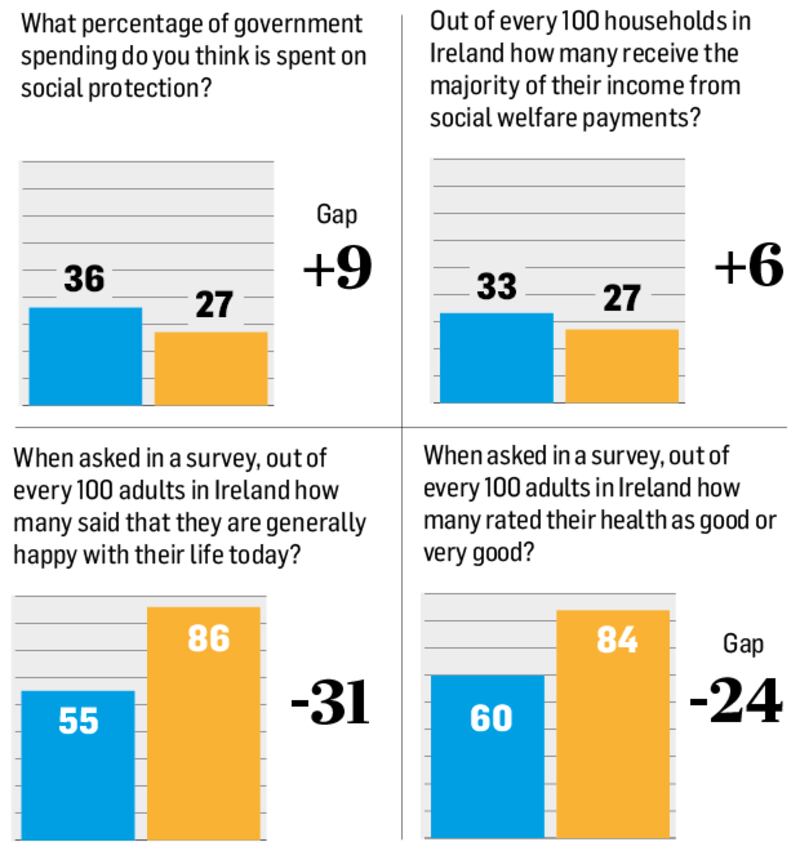
One area where there is a lower gap between the perception and the reality is the gender divide. When asked how much of every €100 men earn do women earn, the perception was €74.70 compared with a reality of €73. When asked how many out of every 100 graduates in Ireland are women, people guessed 53.6 per cent on average – which was almost exactly right. The correct figure is 53 per cent.
Loscher says that if the last century was about state-sponsored propaganda artfully delivered via central channels, this one is about “scrolling your smartphone and picking out the juiciest headlines which can often see people drifting further away from the truth”.
“How accurately we view the world can have huge implications for the decisions we make,” he says. “Research like this is a way of keeping an eye on just how far people are drifting from reality, and it should be a wake-up call to government and media about the need to take much greater care with the information that is put out there.”
Why people get so much wrong
Analysis: How we react to protect and promote news and data integrity should concern us all, writes Damian Loscher
With faces buried in small screens everywhere we look, it is easy to imagine that our sources of news and information have changed dramatically over the past decade. Not so.
The truth is we still get most of our news from established media brands, albeit via a wider selection of channels, including digital. The Reuters Institute 2020 Digital News Report confirms big screen brands such as RTÉ, Sky and BBC still dominate, with the growing online news market led by familiar names wearing new digital clothes: you may be reading this on your smartphone, but you are still reading The Irish Times.
There is a growing perception that social media now dominates as a source of news, but perception is not reality. We still, as a nation, spend more time listening to the radio than we spend on social media. We spend more hours each day watching the big screen than we do watching our small screens.
There is a lot of comfort to be taken from this, because people trust the news they get from TV, radio and newspapers much more than they trust social media news. When asked specifically about information on the Covid-19 crisis, new media (Facebook, Twitter, etc) were given a trust rating of less than half that awarded to TV, radio or to newspapers.
Despite the continued influence and importance of trusted media brands, there is this sinking feeling that accuracy and balance are becoming luxuries in this ultra-competitive, on-demand media environment. The emerging fact-checking industry is an ominous sign.
One way to diagnose the seriousness of the problem is to look for symptoms in the form of gaps between public perceptions and reality, which is why Ipsos MRBI, in association with The Irish Times, is publishing the latest Perils of Perception study.
The first Perils of Perception study was conducted in 2015 as part of a global Ipsos initiative, allowing comparisons to be made between Ireland and the rest of the world. The study revealed we shared the same biases as other countries, but thankfully not to the same extremes. For example, the Irish have a better handle on how widespread obesity is in society, and we are less inclined to exaggerate the size of our immigrant population.
Interestingly, back in 2015, we wildly overstated (as did most countries) the proportion of the population aged 25 to 34 years living with their parents. When we think about the prominent role the housing crisis played in the general election earlier this year, it becomes immediately apparent how vital it is that we get our facts right on important social and economic issues.
It should be acknowledged that gaps between perception and reality are not always the result of misinformation. Much of the population are simply not comfortable with numbers and struggle to understand even simple mathematical concepts. In fact, when it comes to perceptions, we are more likely to trick ourselves than be tricked.
Writing in his book Perils of Perception, which explored in huge detail the findings from the 2015 study, Bobby Duffy noted that countless experiments had shown that around 10 per cent of the public don’t understand simple percentages, never mind more complex maths. The likelihood is that many, if not most, of today’s population are not equipped to navigate the oceans of data we all must swim through every day.
Even if we understand the numbers, human beings can be irrational in our interpretation. Perceptions are formed in a petri dish of human biases and animal instincts. We screen out, consciously and unconsciously, information that is not aligned with our world view, creating the oft-cited echo chamber. Why follow someone on social media whom you don’t agree with?
As social beings, the need to belong and be accepted can be overwhelming, which means we are attracted to ideas that help us fit in. Tribalism often trumps rational argument, evidenced by the explosion of late in partisan politics around the world.
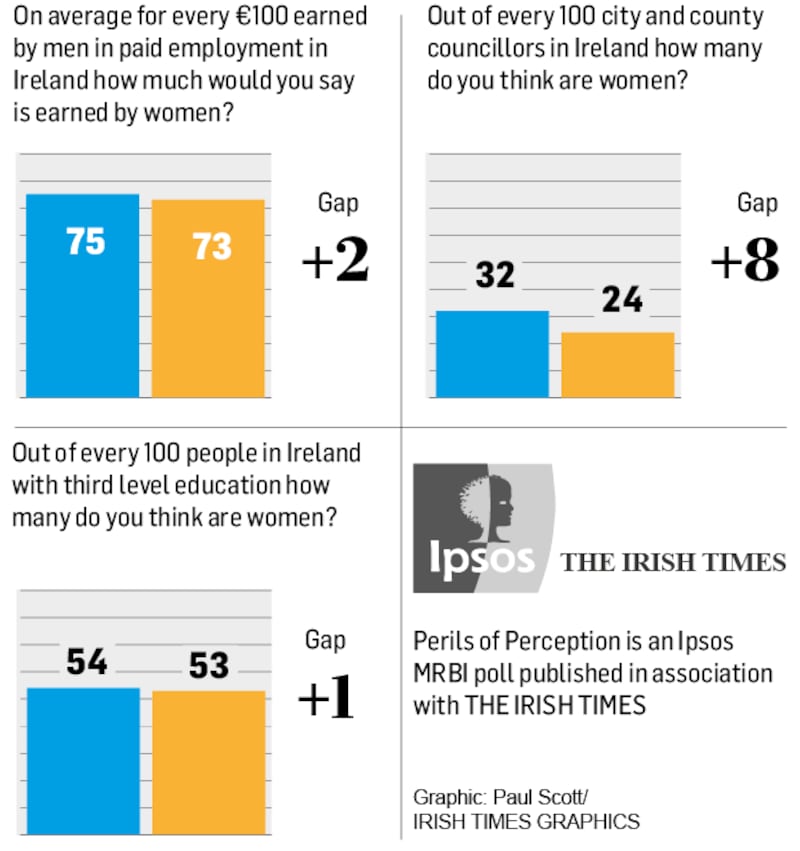
We no longer think the world is flat, but we still struggle to imagine a world beyond our own experience (known to behavioural economists as availability bias). Our tendency to overstate the amount of time we spend with social media is partly because we observe other people consuming media when they are out and about (staring down at their smartphones), but rarely get to see how others consume media at work or at home (listening to the radio during breakfast or watching the evening news).
Fear shapes our perceptions. Sometimes it is fear of change, which is a factor in the almost universal tendency for populations to imagine the rate of immigration in their country to be much higher than it actually is.
Other times it is fear for our health and the health of others. In Ireland, young people fear Covid-19 more than they worry about being in a car accident, which is statistically irrational and highlights how difficult we find it to calibrate perceptions of risk.
It is impossible to discuss how we form our opinions in this modern age without specifically mentioning the growing influence of social media. Social media is the conduit for much of the news we consume nowadays.
Unfortunately, when news goes on a journey before it gets to us, it loses an amount of accountability and traceability on the way. Never has this been truer than in this time of Covid-19, when the sharing of unverified information on social media in the early days of the crisis attracted the ire of then taoiseach Leo Varadkar.
It was not supposed to be this way. It was expected that the internet would democratise the news, making citizen journalists of us all. Instead, we have swapped institutional bias (where what we watch, listen to or read may be slanted editorially) for individual bias (where we surf for the stories that reinforce our own opinions and prejudices).
Arguably this has been the most important shift in media behaviour this century.
How we react to protect and promote news and data integrity is something that should concern us all. Media literacy initiatives such as the Be Media Smart campaign, organised by the Broadcasting Authority of Ireland and supported by almost all Irish media outlets, are to be welcomed. Long reads and slow journalism are gaining traction. But so much more needs to be done.
Ultimately, there is no reliable data to confirm or deny that the gaps between perception and reality are growing, but the anecdotal evidence is compelling. We only know, confirmed by the latest Perils of Perceptions study, that significant gaps exist.
Perception is reality. Mind the gap.
Damian Loscher is managing director of Ipsos/MRBI





















